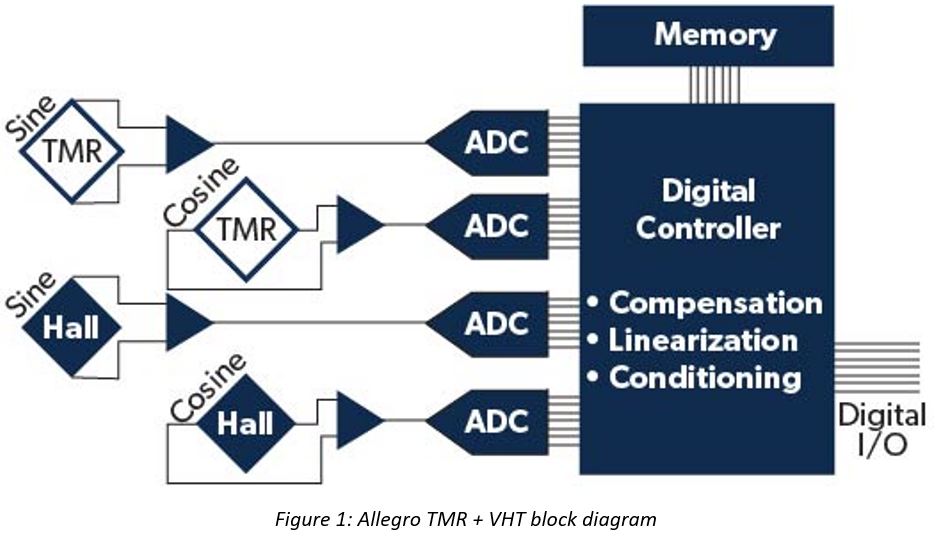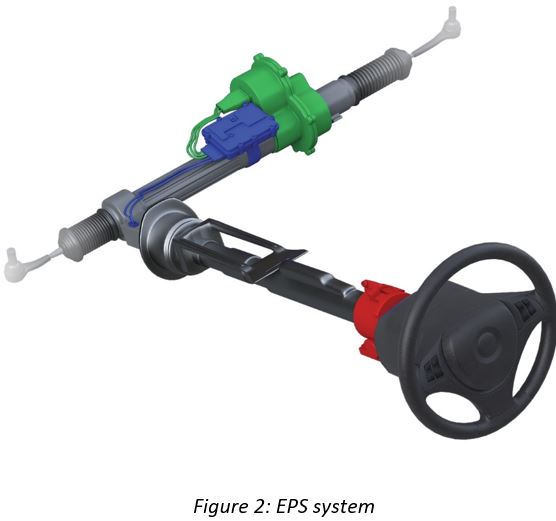Allegro TMR: A Cutting-Edge Sensing Solution for Driving Automation and ADAS
As vehicle electrification has increased over the years in the automotive industry, standards such as SAE J3016TM have established levels of automation where automated driving elements have become increasingly adopted across broad classes of vehicles. These include advanced driver assistance systems (ADAS) that require robust and reliable hardware and software for use in detection and recognition systems, and vehicle correction and avoidance control.
Steering and braking systems are critical to driving automation and ADAS control and safety. Electronic technology developments are leading to innovative new systems such as steer-by-wire and brake-by-wire. These rely on motor control designs to satisfy the performance and safety requirements of automotive manufacturers and to deliver the best end-user experience. These safety-critical systems are designed with internal diagnostic capabilities, including redundancy to detect and react against internal faults, ensuring safe operation in the event of system failure. Magnetic sensors have been the solution of choice for motor position control due to their reliability, small footprint, and Automotive Safety Integrity Level (ASIL) compliance per ISO 26262.
Recently, Allegro raised the bar in magnetic sensor technology by introducing the A33110 and A33115, the industry’s first heterogeneous tunneling magnetoresistance (TMR) and vertical Hall technology (VHT) angle sensor devices, as shown in Figure 1.
Named as such due to their construction, these TMR+VHT sensor ICs built in a manner combining both technologies—typically separate—in a single-package design, are high-resolution contactless angle sensors capable of measuring angular position, rotational speed, and direction over 360 degrees. Both sensors are ASIL D-compliant in a single package that reduces the overall footprint and number of components. Heterogeneous redundancy (diverse redundancy) in a system architecture that provides functional safety requires redundant functionality from a dissimilar technology, construction, or design. In terms of systematic fault detection, diversity is more effective, and may reduce the likelihood of dependent failures compared to homogeneous-redundant solutions.

The magnetic detection circuit in the Allegro devices provides both primary (TMR) and secondary (VHT) sensors that use independent signal processing channels. The TMR channel provides 14-bit noise-free resolution for precision control, while the VHT channel provides 10-bit noise-free resolution suited for safety checks, including checks such as low-field and missing magnet detection. Sensor internal error detection is performed by on-chip diagnostics (internal safety mechanisms) and error flags that can be used in system design with minimal analysis of the data received from the sensor.
Safety in Focus
Applications within ADAS
ADAS Applications
Braking and Steering Applications
The two distinct primary and secondary channels operating independently provide an important safety component in ADAS applications. The TMR channel makes the Allegro sensors particularly well-suited for use in electronic power steering (EPS), steer-by-wire, brake-by-wire, and electromechanical braking (EMB) systems. The use of high-resolution TMR technology can reduce motor feedback in the steering system to enable smoother movement in the steering wheel and, potentially, less audible motor noise in the cabin. This benefit is seen in electrified vehicles (EVs); less audible noise helps to provide the whisper-quiet cabin EV drivers readily expect.

With respect to braking applications, the safety and performance advantages of the TMR+VHT solutions truly shine. These ASIL D-compliant devices offer the key benefits of high-level safety and diagnostic coverage and heterogeneous redundancy. Additionally, the sensors provide a fast response time to aid in the high-speed motor position control needed in advanced braking systems. As ADAS and automated driving capabilities are integrated into vehicles, and overall automotive advancements occur systems that keep the driver safe in split-second situations are an increasingly important point in vehicle development.
Less Installation Space Required
Advantages of Allegro's TMR and Hall Sensor Technology
Reducing System-Level Complexity
Aside from these major safety merits, the sensors are set apart from other solutions in several ways. For one, the combination of an TMR and Hall sensor technology is unique to Allegro and is distinguished in providing heterogeneous redundancy, and low-field and missing-magnet detection.
The ICs also operate over a wide operating voltage, from 3.7 to 18 V. This allows direct connection to the vehicle battery voltage and removes the need for voltage regulators within a system design—a notable distinction for system engineers considering cost and area impact in designs.
The devices include an integrated turns counter with logic that tracks the magnet position and updates a counter to track the angle in 90-degree increments. This incremental tracking preserves direction detection of the turns count. The primary turns-count updates based on the absolute angle measured by the primary channel and the secondary turns-count updates based on the absolute angle measured by the secondary channel.
Turns counting in a key-off condition, common for vehicle servicing, is an important requirement in EPS systems. Traditionally, this key-off requirement is achieved by a combination of relatively complex mechanical and electronic components. The A33115 helps reduce system-level complexity and eliminate many components by performing both the absolute angle measurement and the tracking of the turns-count, while maintaining low battery power consumption, with a typical supply current of only 50 mA. The A33115 is an industry-first TMR two-dimensional angle sensor providing this capability.
Both of the new Allegro sensor IC solutions allow eight distinct EEPROM-selectable combinations of TMR and VHT channels to provide ABI/UVW, PWM, or SPI output protocols, as well as reading of either channel via SPI. This unique feature facilitates custom heterogeneous comparison for the channels, allowing the user to tailor each channel to meet their specific functional and application needs.
Linearization is available as an EEPROM-selected option to reduce error from misalignment between the sensor and target magnet. It removes angle error resulting from mechanical and magnetic nonidealities. The linearization circuits provide this correction with minimal added latency.
Future Mobility
Looking Towards the Future
The Future of the Automotive Technology
As the automotive industry looks to the future of its vehicles, especially regarding the advancements of electrification and driver safety, the various systems and components need to perform at a high level. Suppliers, engineers, and original equipment manufacturers must place strong focus on safety and reliability and be mindful of end-user comfort and convenience.
The unique feature set of solutions, such as the TMR sensors from Allegro, provide engineers with solutions to meet the safety and performance needs of today while paving the way for the systems of tomorrow.
Based on the article, "High Reliability" by Scott Pavlik, originally published in Hanser Automotive, October 5th, 2022. Republished with permission. For portions not copyrighted by original publisher, Copyright ©2023, Allegro MicroSystems, Inc.
Copyright 2023, Allegro Microsystems.
The information contained in this document does not constitute any representation, warranty, assurance, guaranty, or inducement by Allegro to the customer with respect to the subject matter of this document. The information being provided does not guarantee that a process based on this information will be reliable, or that Allegro has explored all of the possible failure modes. It is the customer's responsibility to do sufficient qualification testing of the final product to ensure that it is reliable and meets all design requirements.
Copies of this document are considered uncontrolled documents.